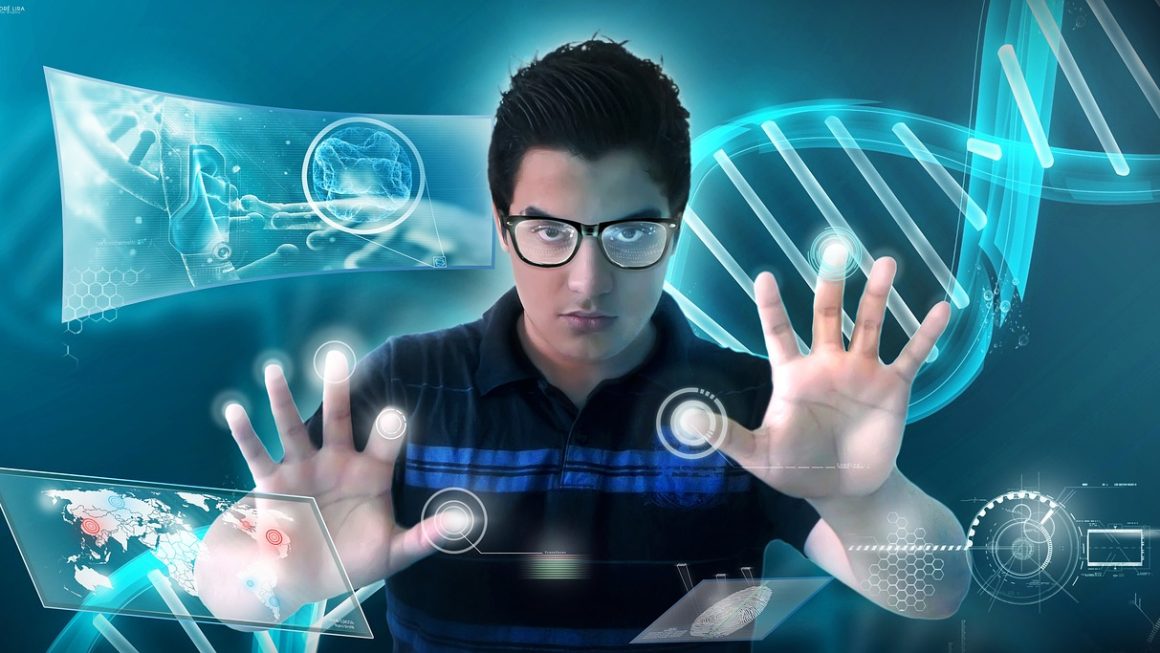Augmented Reality (AR) and Virtual Reality (VR) are no longer futuristic fantasies confined to science fiction. They are rapidly transforming industries, reshaping consumer experiences, and blurring the lines between the physical and digital worlds. This blog post explores the nuances of AR/VR, providing a comprehensive overview of their applications, technologies, and future potential. Whether you’re a tech enthusiast, business leader, or simply curious about these immersive technologies, this guide will provide valuable insights into the exciting realm of AR and VR.
Understanding Augmented Reality (AR)
What is Augmented Reality?
Augmented reality enhances the real world by overlaying digital information, such as images, text, and 3D models, onto our view of it. Unlike VR, which creates completely immersive digital environments, AR supplements reality. Think of it as adding a digital layer on top of what you already see.
How AR Works
AR systems typically use a combination of:
- Cameras: To capture the real-world environment.
- Sensors: Such as GPS, accelerometers, and gyroscopes, to determine the user’s location and orientation.
- Processing Power: To analyze the captured data and render the digital augmentations.
- Display Technology: Such as smartphones, tablets, or specialized AR headsets, to present the augmented view.
Modern AR relies heavily on SLAM (Simultaneous Localization and Mapping) algorithms to create a 3D understanding of the environment, enabling more accurate and stable augmentations.
Practical AR Applications
The applications of AR are diverse and growing rapidly. Here are some examples:
- Retail: Trying on clothes virtually, visualizing furniture in your home before purchasing. IKEA’s Place app is a great example of this in action, letting you virtually place furniture in your home using your smartphone camera.
- Education: Interactive textbooks and educational games that bring learning to life. For instance, an AR app could allow students to dissect a virtual frog without needing a real specimen.
- Manufacturing: Providing technicians with step-by-step instructions overlaid on equipment for easier maintenance and repairs. Boeing has used AR to reduce wiring installation time by 25% and decrease error rates.
- Navigation: Overlaying directions on the real-world view for more intuitive navigation. Google Maps Live View is a prime example of this.
- Gaming: Enhancing gameplay with location-based elements and augmented characters. Pokémon GO is a highly successful example.
- Healthcare: Assisting surgeons during procedures by providing real-time data and imaging overlays.
Delving into Virtual Reality (VR)
What is Virtual Reality?
Virtual Reality, in contrast to AR, creates fully immersive, computer-generated environments. Users are completely cut off from the real world and transported into a simulated reality.
How VR Works
VR systems typically consist of:
- Headset: A head-mounted display (HMD) that presents stereoscopic images to each eye, creating a sense of depth and immersion.
- Motion Tracking: Sensors track the user’s head and body movements, allowing them to interact with the virtual environment. Technologies used include inside-out tracking (cameras on the headset) and external base stations.
- Controllers: Handheld devices that allow users to interact with objects and navigate the virtual world.
- Audio: Spatial audio is crucial for creating a believable and immersive experience, allowing sounds to appear to come from specific locations in the virtual environment.
Practical VR Applications
VR is impacting various industries, offering unique opportunities for training, entertainment, and more.
- Gaming: Immersive gaming experiences that place players directly inside the game world. Examples include games like Beat Saber and Half-Life: Alyx.
- Training and Simulation: Realistic simulations for training pilots, surgeons, and other professionals in high-risk environments. VR flight simulators are used extensively for pilot training, allowing trainees to experience a variety of scenarios safely.
- Education: Virtual field trips and interactive learning experiences that transport students to different locations and time periods. Imagine exploring ancient Rome or dissecting a human heart in a VR environment.
- Healthcare: Pain management, therapy for phobias, and rehabilitation. VR can be used to distract patients from pain during medical procedures or to help people overcome their fear of heights.
- Real Estate: Virtual tours of properties that allow potential buyers to explore homes from anywhere in the world.
- Entertainment: Immersive movies, concerts, and other live events.
The Technological Underpinnings of AR/VR
Hardware Components
Both AR and VR rely on sophisticated hardware. Key components include:
- Processors: Powerful processors are needed to render complex graphics and handle real-time tracking. Qualcomm Snapdragon XR platform is designed specifically for XR devices.
- Displays: High-resolution displays with fast refresh rates are crucial for creating a visually compelling and comfortable experience. OLED and micro-LED displays are commonly used.
- Sensors: A wide range of sensors are used for motion tracking, environmental understanding, and user input. These include accelerometers, gyroscopes, magnetometers, and depth sensors.
- Connectivity: Reliable wireless connectivity (Wi-Fi 6, 5G) is essential for streaming content and interacting with other devices.
Software and Development
Developing AR/VR experiences requires specialized software and tools:
- Game Engines: Unity and Unreal Engine are the most popular game engines for creating AR/VR applications.
- AR/VR SDKs: ARKit (Apple), ARCore (Google), and OpenXR provide developers with the necessary tools and APIs to access device capabilities and build AR/VR experiences.
- 3D Modeling Software: Tools like Blender, Maya, and 3ds Max are used to create 3D models and environments.
- Programming Languages: C#, C++, and other programming languages are used to develop the logic and functionality of AR/VR applications.
The Role of 5G and Cloud Computing
5G and cloud computing are playing an increasingly important role in AR/VR:
- 5G: Provides the high bandwidth and low latency required for streaming high-resolution AR/VR content wirelessly.
- Cloud Computing: Enables offloading computationally intensive tasks to the cloud, allowing for more powerful and complex AR/VR experiences on mobile devices. Cloud rendering can significantly improve the graphical fidelity of VR applications.
The Future of AR/VR
Emerging Trends
Several trends are shaping the future of AR/VR:
- Lightweight and Comfortable Headsets: Manufacturers are working to create more comfortable and aesthetically pleasing headsets that people will want to wear for extended periods.
- Improved Tracking and Interaction: Advanced tracking technologies, such as eye tracking and hand tracking, are enabling more natural and intuitive interactions with virtual environments.
- Metaverse Development: The metaverse, a shared virtual world, is driving demand for AR/VR technologies. Companies are investing heavily in creating virtual experiences and platforms within the metaverse.
- AR Glasses: Sleek and stylish AR glasses that can be worn throughout the day are becoming a reality. These glasses will offer a seamless blend of the digital and physical worlds.
- Spatial Computing: This refers to the ability of computers to understand and interact with the physical world. Spatial computing is powering new applications in areas such as robotics, autonomous vehicles, and smart homes.
Challenges and Opportunities
While AR/VR has enormous potential, there are also challenges that need to be addressed:
- Cost: High-end AR/VR equipment can be expensive, limiting accessibility.
- Comfort and Usability: Some users experience motion sickness or discomfort when using AR/VR devices.
- Content Creation: Creating high-quality AR/VR content can be time-consuming and expensive.
- Privacy and Security: AR/VR devices collect a lot of personal data, raising concerns about privacy and security.
The opportunities are equally significant:
- Revolutionizing Industries: AR/VR has the potential to transform industries such as healthcare, education, manufacturing, and entertainment.
- Creating New Jobs: The AR/VR industry is creating new jobs in areas such as content creation, software development, and hardware engineering.
- Improving Quality of Life: AR/VR can be used to improve quality of life for people with disabilities, provide access to education and training in remote areas, and enhance entertainment experiences.
Conclusion
Augmented Reality and Virtual Reality represent a paradigm shift in how we interact with technology and the world around us. While challenges remain, the potential of these immersive technologies to transform industries and enhance our lives is undeniable. As hardware becomes more affordable and accessible, and software development continues to advance, AR/VR is poised to become an integral part of our daily lives, blurring the boundaries between the physical and digital realms. Keeping abreast of these developments is crucial for businesses and individuals alike, as AR/VR continues to evolve and reshape the future.




